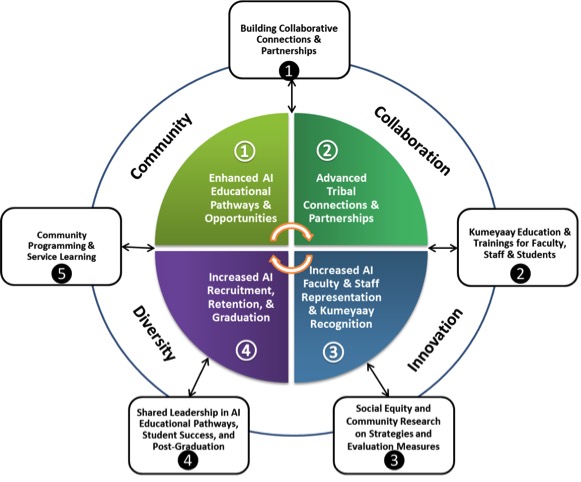Waipuk's Vision
Model of Indigenous Diversity and Inclusion
“Creating an Inclusive Culturally-Responsive and Belonging Environment”
In spite of the historical legacy of exploitation, educational and environmental injustices, dispossession of cultural values, and oppression of tribal sovereignty, Indigenous students’ secure connection to their cultural heritage and community promotes resilience, a key strength among Native communities.
The Model of Indigenous Diversity and Inclusion supports SDSU’s Division of Diversity and Inclusion (Innovation) vision and mission statements of making SDSU a home for “students, faculty, staff, and alumni of all backgrounds and identities” and “advancing the welfare of all peoples.” It is essential to cultivate a safe, nurturing, and empowering support system and a sense of belonging for Indigenous students, faculty, staff, and alumni.
The Model of Indigenous Diversity and Inclusion illustrates a radial-process concept map showing four centralized goals concerning the outer five areas, emphasizing how the information in the outer ring of boxes contributes to the centralized goals. The Model of Indigenous Diversity and Inclusion creates a sup- port system needed for Indigenous students to thrive in school. The following are the four centralized goals identified on the concept map:
-
Enhance AI Educational Pathways & Opportunities
-
Advance Tribal Connections and Partnerships
-
Increase AI Faculty & Staff Representation & Kumeyaay Recognition
-
Increase AI Representation, Retention, and Graduation

![]() Thus to attain these centralized goals, the Tribal Liaison will strategically work
in the following five areas:
Thus to attain these centralized goals, the Tribal Liaison will strategically work
in the following five areas:
Overall, increasing diversity and inclusion isn’t a cookie-cutter process. A critical starting point is “Creating an Inclusive Culturally-Responsive and Belonging Environment” for Indigenous and non-Indigenous students by institutionalizing Indigenous Diversity and Inclusion in all facets of the University. Institutionalizing Indigenous Diversity and Inclusion requires a shared vision, commitment, and participation, a support system in place, a fair representation of all constituents, customized efforts, and the use of but not limited to shared leadership, culturally relevant/responsive pedagogy, participatory action research, and collective impact approaches.
